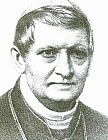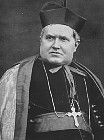

Birth. January 16, 1814, Torda, village of Banat, diocese of Csanád, Hungary. Son of Istvan Mihalovic, an official. His first name is also listed as József; amd his last name as Mihalovits; and as Mihalovich. Received the sacrament of confirmation in 1826.
Education. Elementary school in Torda; completed his high school in Bečkereku; then, studied at the Gymnasium of Szeged (philosophy); and at the Seminary of Temesvar (theology). Received the insignias of the clerical character and the minor orders on February 27, 1831; the subdiaconate on January 17, 1835; and the diaconate on April 18, 1835
Priesthood. Ordained, August 12, 1836 (or 1834). In the diocese of Csanád, he was curate of the parish of the city of Timișoara; episcopal caeremoniarius and notary of the Holy See, 1837; secretary and assessor, 1842; director of the episcopal chancery, 1846; pro-vicar general; pastor; vice-archdeacon; inspector of schools; abbot of St. Mihal de Vaska.
Episcopate. Elected archbishop of Zagreb, June 27, 1870. Consecrated, July 17, 1870, Dominican church, Vienna, by Mariano Falcinelli Antoniacci, O.S.B.Cas., titular archbishop of Atena, nuncio to Austria, assisted by Johann Rudolf Kutschker, titular bishop of Carre, auxiliary of Vienna, and by Dominik Mayer, titular bishop of Cisamo, military ordinary of Austria.
Cardinalate. Created cardinal priest in the consistory of June 22, 1877; received the red hat and the title of S. Pancrazio, June 25, 1877. Participated in the conclave of 1878, which elected Pope Leo XIII. In 1878, he established a minor seminary and gymnasium. In cultural and church affairs, he left a profound mark.
Death. February 19, 1891, Zagreb. Exposed and buried in the metropolitan cathedral of Zagreb.
Bibliography. "Cardinali defunti." La Gerarchia Cattolica e la Famiglia Pontificia per l'anno 1903, Città del Vaticano : Tipografia poliglotta vaticana, 1903, p. 189; Izvor: Maruševski, O in Juraj Batelja; Franko Mirošević. Zagrebački biskupi i nadbiskupi. Zagreb : Školska Knjiga, 1995, p. 475-478; Ritzler, Remigium, and Pirminum Sefrin. Hierarchia Catholica Medii et Recentioris Aevi. Volumen VIII (1846-1903). Patavii : Typis et Sumptibus Domus Editorialis "Il Messaggero di S. Antonio" apud Basilicam S. Antonii, 1979, pp. 22, 51 and 600.
Webgraphy. His portrait and biography, in Croatian, archdiocese of Zagreb; biography, in Hungarian, Magyar Katolikus Lexikon, second on page; The Mihalović Family, in Croatian, Enciklopedija.hr; engravings and photograph, Araldica Vaticana.

Birth. April 11, 1810, Wiese (now Loucky), Seifersdorf, archdiocese of Olomouc, Moravia. His father was a weaver and small farm owner. Received the sacrament of confirmation, 1820. His first name is also listed as Johann Baptiste Rudolf; and his last name as Kutskhker.
Education. Studied the Gymnasium in Troppau from 1821 to 1826; then, studied humanities and philosophy at the Lyceum of Olomouce until 1828; and later, he studied theology, for seven years, at the Stadtkonvikt and at the Frintaneum, University of Vienna, obtaining a doctorate with a dissertation on "mixed marriages" (1838).
Priesthood. Ordained, April 21, 1833, Vienna. Professor of of moral theology at the University of Olomouc from 1835 until 1852. In 1843, he became chancellor of the Olomouc archiepiscopal consistory. In 1852, Emperor Franz Joseph named him pastor of the royal and imperial palace. He was also named president of the Frintaneum, where he had studied. appointed by the emperor counselor to the ministry of culture and public institutions, 1857-1876. Named domestic prelate of His Holiness. He published Das Eherecht der katholischen Kirche nach seiner Theorie und Praxis, 4 vols., 1856-1857; and Das Eherecht der katholischen Kirche nach seiner Theorie und Praxis, 5 vols., 1856-1857.
Episcopate. Elected titular bishop of Carre and appointed auxiliary of Vienna, April 7, 1862. On May 10, 1862, he was appointed vicar general of Vienna. Consecrated, May 11, 1862, Vienna, by Joseph Othmar Rauscher, archbishop of Vienna, assisted by Arnošt Schaaffgotsche, bishop of Brno, and by Ignaz Feigerle, bishop of Sankt Pöllten. Promoted to the metropolitan see of Vienna, April 15, 1876.
Cardinalate. Created cardinal priest in the consistory of June 22, 1877; received the red hat and the title of S. Eusebio, June 25, 1877. Participated in the conclave of 1878, which elected Pope Leo XIII.
Death. January 27, 1881, Vienna, at 11:35 a.m., probably of a stroke. Exposed in the metropolitan cathedral of Vienna, Stephansdom; and buried in the bishops' tomb in that metropolitan cathedral.
Bibliography. "Cardinali defunti." La Gerarchia Cattolica e la Famiglia Pontificia per l'anno 1903, Città del Vaticano : Tipografia poliglotta vaticana, 1903, p. 175; Ritzler, Remigium, and Pirminum Sefrin. Hierarchia Catholica Medii et Recentioris Aevi. Volumen VIII (1846-1903). Patavii : Typis et Sumptibus Domus Editorialis "Il Messaggero di S. Antonio" apud Basilicam S. Antonii, 1979, pp. 22, 48, 184 and 590.
Webgraphy. His portrait and brief biographical data, in German, aeiou.at, Österreich-Lexikon; his engraving and biography, in German, kutschker.de; his arms and photograph, Araldica Vaticana.

Birth. August 13, 1833, Mantua. Son of Antonio Parocchi, a rich miller, and Genoveva (Ginevra) Soresina. His father died when he was five years old. Received the sacrament of confirmation in 1840.
Education. Studied at the Seminary of Mantua from 1847; between 1850 and 1852 he received the ecclesiastical tonsure and the minor orders from Bishop Giovanni Corti of Mantua; in 1854, the bishop sent him to study at Collegio Romano, where he obtained a doctorate in theology on September 5, 1856.
Priesthood. Ordained, May 17, 1856, Rome, by Cardinal Costantino Patrizi Naro, vicar of Rome. In the diocesan seminary of Mantua, he was professor of ecclesiastical history, moral theology, and canon law. In te diocese of Mantua, he was archpriest of the parish of Ss. Gervasio e Protasio; and prefect of its cathedral. Socius of the Academy of the Catholic Religion, Rome, June 22, 1870. Domestic prelate of His Holiness, March 10, 1871. Founder of the journal La Scuola Cattolica, 1871.
Episcopate. Elected bishop of Pavia, October 27 (1), 1871. Consecrated, November 5, 1871, in the church of SS. Trinità al Monti Pincio, Rome, by Cardinal Costantino Patrizi Naro, bishop of Ostia and Velletri, dean of the Sacred College of Cardinals, assisted by Pietro Villanova Castellacci, titular archbishop of Petra, and by Salvatore Nobili Vitelleschi, bishop of Osimo. Promoted to the metropolitan see of Bologna, March 12, 1877.
Cardinalate. Created cardinal priest in the consistory of June 22, 1877; received the red hat and the title of S. Sisto, June 25, 1877. Participated in the conclave of 1878, which elected Pope Leo XIII. Resigned the pastoral government of the archdiocese of Bologna on June 28, 1882. Named Vicar General of His Holiness for the City of Rome and its District on February 16, 1884; occupied the post until 1899. Prefect of the S.C of the Residence of Bishops from February 16, 1884 to December 14, 1899. Opted for the title of S. Croce in Gerusalemme, March 24, 1884. In 1886, he founded the Congregazione della Suore dei Sacri Cuori di Gesù e Maria. Camerlengo of the Sacred College of Cardinals from June 1, 1888 until February 11, 1889. President of Academy of the Catholic Religion, Rome, March 13, 1889. Opted for the order of cardinal bishops and the suburbicarian see of Albano, May 24, 1889. Secretary of the Supreme S.C. of the Universal and Roman Inquisition from August 5, 1896 until his death. Opted for the suburbicarian see of Porto e Santa Rufina, November 30, 1896. Vice-chancellor of the Holy Roman Church from December 14, 1899 until his death. Commendatario of the title of S. Lorenzo in Damaso, assigned to the vice-chancellor, from December 14, 1899 until his death. President of the cardinalitial commission for the election of Italian bishops. Legate a latere for the closing of the Holy Door at the patriarchal basilica of S. Paolo fuori le mura at the end of the Holy Year of 1900.
Death. January 15, 1903, at 2:00 a.m., in Rome, of heart disease, while he was reciting Psalms. Exposed in the Palace of the Chancery and in the basilica of S. Lorenzo in Damaso, Rome, where the funeral took place. Buried in the chapel of the S.C. of Propaganda Fide, Campo Verano Cemetery, Rome.
Bibliography. Coppa, Isidora. Cardinale Lucido Maria Parocchi : vescovo, profeta, apostolo, fondatore, servitore del Vangelo. Gorle (BG) : Cascine Vica, Rivoli (TO) : Velar ; Elle Di Ci, 2009; Daniel, Charles; Paul-Marie Baumgarten; Antoine de Waal. Rome; le chef suprême l'organisation et l'administration centrale de l'église. Paris : Plon, 1900, pp. 131-133; De Camillis, Mario. "Parocchi, Lucido Maria." La Enciclopedia Cattolica, 12 vols. Città del Vaticano: Ente per l'Enciclopedia Cattolica e per il Libro Cattolico, 1949-1954, IX, cols. 853-854; Meluzzi, Luciano. I vescovi e gli arcivescovi di Bologna. Bologna : Grafica Emiliana, 1975, (Collana storico-ecclesiastica; 3), pp 527-530; Ritzler, Remigium, and Pirminum Sefrin. Hierarchia Catholica Medii et Recentioris Aevi. Volumen VIII (1846-1903). Patavii : Typis et Sumptibus Domus Editorialis "Il Messaggero di S. Antonio" apud Basilicam S. Antonii, 1979, pp. 22-23, 43, 44, 48, 49, 53, 153 and 439; Weber, Christoph. Kardinäle und Prälaten in den letzten Jahrzehnten des Kirchenstaates : Elite-Rekrutierung, Karriere-Muster u. soziale Zusammensetzung d. kurialen Führungsschicht zur Zeit Pius' IX. (1846-1878). Stuttgart : Hiersemann, 1978. (Päpste und Papsttum; Bd. 13, I-II), II, 499-500, 748 and 757.
Webgraphy. Biography by Domenico Rocciolo, in Italian, Dizionario Biografico degli Italiani - Volume 81 (2014), Treccani; his portrait and biography by Paolo Risso, Santi/Beati, aggiunto il 2009-07-16; photographs, engraivings, portrait and arms, Araldica Vaticana.
(1) This is according to Ritzler, Hierarchia Catholica Medii et Recentioris Aevi, VIII, 439; Meluzzi, I vescovi e gli arcivescovi di Bologna, p. 527; Weber, Kardinäle und Prälaten in den letzten Jahrzehnten des Kirchenstaates, II, 499, says that he was elected on October 22, 1871.
| Top | Consistories | Catalogs | Home |
©1998-2019 Salvador Miranda.